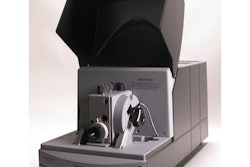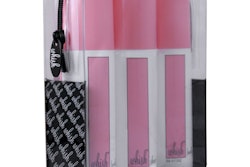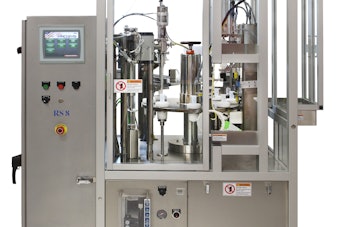Cheer Pack North AmericaThe first Nest Collective product to appear in the Cheer Pack pouch was Revolution Foods Mashups. This line of organic fruit purees comes in 3.17-oz stand-up pouches that are aimed at the school lunch crowd. They’re filled by a contract packager on a Model CHP40 pouch filler made by Gualapack. Mashups were launched in early 2008, and a four-pack sells for $4.99.
More recently, in February of 2009 to be precise, The Nest Collective acquired Plum Organics, a leading provider of frozen, organic baby food and toddler meals. Within a year, the Plum Organics line had been converted from thermoformed cups with flexible film lidding and is now in a Cheer Pack pouch. And because hot-filling makes the pouches shelf-stable, Plum Organics no longer need to be kept frozen.
“When we acquired Plum Organics, we felt the existing package didn’t offer the accessibility, portability, and convenience we wanted,” says Neil Grimmer, co-founder and chief innovation officer of The Nest Collective. “The product had to be thawed before it could be served.”
That’s why the company borrowed a page from its Revolution Foods line and began putting Plum Organics in a Cheer Pack pouch. “In short order, we discontinued the frozen format,” says Grimmer. “It was clear right away that parents were voting with their dollars where the pouch format was concerned.”
Grimmer also believes that the pouch format is far superior to the glass jar, which is still the workhorse where baby food packaging is concerned.
“The whole idea here is delivering more healthful foods to babies,” says Grimmer. “Glass jars are retorted, and freshness, taste, and nutrient values are not best served by the retorting process.”
Foil and polyester
The Plum Organics pouches, like the Mashups that preceded them, are made from a three-layer lamination of polyester/aluminum foil/polyethylene. The outer layer of polyester is reverse printed on a gravure press in eight to ten colors. The injection-molded linear low-density polyethylene spouts are heat-sealed to the film.
Grimmer acknowledges that pouch formats other than the Cheer Pack are available. But a number of attributes offered by the Cheer Pack make it the option Grimmer and his colleagues prefer.
“First, it’s a premade pouch with a sealed spout already securely in place,” says Grimmer. “Other options have the spout getting dropped in and sealed to the pouch in a form/fill/seal operation. But knowing the condition of a food plant—the amount of moisture in particular—we felt that putting the spout on the pouch in the food plant was a suboptimal way of assuring seal integrity. We also like the premium look and feel of this pouch. The edges are rounded to minimize any chance of small fingers getting accidentally cut. And we like the cap. Not only does the cap have good aesthetic appeal, it adheres to the kind of safety standards that operate in the toy industry.”
A look at the machinery At the contract packaging company where The Nest Collective’s pouches are being produced, premade pouches arrive in a magazine format where 53 individual pouches are held between plastic rails. An operator loads these 53-count magazines into the CHP40, an intermittent-motion rotary machine that runs at 40 pouches/min. It picks pouches from the magazine feed and then brings them around to eight different stations. These operations follow in succession:
• Pouch is mechanically picked from the magazine feed and mounted on the rotary indexing wheel
• Ink-jet date coding takes place
• A vacuum is drawn so the pouch has no ambient air in it and the pouch is filled
• The spout is steam cleaned to make sure there is no product to interfere with secure application of the closure
• Cap is applied
• Servo-driven torquing station torques on the closure
• Sensors detect if the cap has been torqued into position properly
• Pouch is discharged
Finished packs are shelf-stable because this is a hot-fill process. The heat of the product sterilizes the inside of the pouch. Immediately after pouches are discharged from the CHP40, some secondary pasteurizing is done in a 30-ft-long steam tunnel whose temperature is 88 deg C. A cooling bath follows immediately to keep the product from “cooking” any longer than it needs and to make it easier to handle the finished pouches. Pouches produced for The Nest Collective are either 3.17 or 4.22 oz. But changeover from one to the other is simplified because the only part of the pouch gripped by the filling system is the 8.6 mm diameter spout, and that doesn’t change from one pouch to another.
Grimmer also points out that the pouch format compared to conventional glass jars is more desirable from a sustainable packaging standpoint. “Weight reduction advantages gained throughout the supply chain are enormous,” he points out. “We estimate that it takes nine times more fossil fuel to move glass around compared to what’s required to move this pouch around. And if you look at it from an end-of-life perspective, our packaging occupies about 1⁄14 the amount of space in the landfill as glass.”
Secondary packaging of Plum Organics is a six-count paperboard carton that is filled by hand. Suggested retail price per pouch is about $1.49 for the 4.22-oz pouch.
Dispensing from the pouch can be done in one of three ways. Tots are able to squeeze product directly into their mouths. For little babies, mom or dad squeezes product onto a spoon. Or, thanks to a recent partnership formed with toy maker Boon, Inc., mom or dad can easily attach a dispensing spoon for a one-piece squeeze-and-feed approach.
“We think this pouch format is baby food 2.0,” says Grimmer. “Portability and convenience are greatly enhanced, and generally speaking it’s just a delightful feeding experience. Add the Boon spoon to it, and you’re looking at a game changer.”























